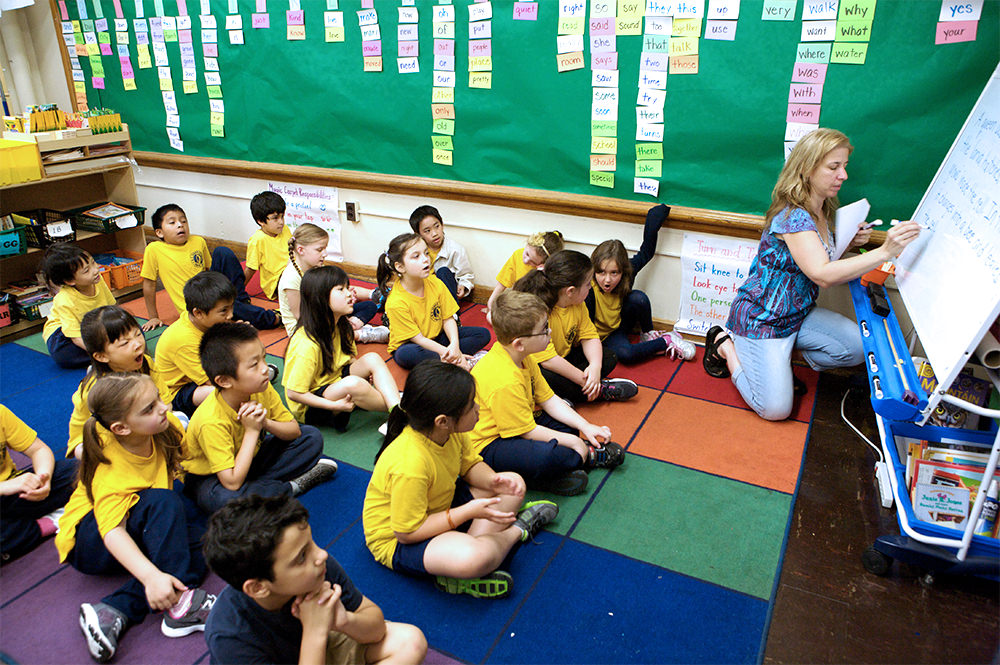During Message Time Plus
At this point, you are ready to write your pre-planned message as the children read along.
MTP (K) - During the Message
While you write, listen to the children’s use of prediction and their decoding skills. Respond with specific praise when you hear them using successful strategies. If you hear them misreading, use the opportunity to quickly unpack the word for them, coaching them both in the moment and in the context of their miscue. Building and strengthening their fluency skills is also an integral part of this phase. Guide them to read with expression and with appropriate phrasing.
Fluency and MTP
One important way teachers grow children’s reading skills is by offering instruction in fluency. Reading fluency refers to children’s ability to read words effortlessly, automatically, and with expression that reflects the meaning of the text. As Tim Rasinksi states in The Fluent Reader, “Fluency has often been called the bridge from phonics to comprehension. The link to phonics occurs when readers develop automaticity in their word recognition. The link to comprehension occurs when readers embed meaningful expression in their reading.”
MTP is a perfect instructional practice for focusing on fluency because of the multiple opportunities for re-reading. Here are some common fluency skills you can model, teach, and have children practice, in order to help them read with expression and accuracy and demonstrate comprehension.
- Read with appropriate phrasing
- Incorporate appropriate pauses
- Read with the appropriate rate
- Attend to punctuation
- Read smoothly
- Articulate clearly
- Read at an appropriate volume
- Use expression to signal comprehension
Responding and Supporting Children as They Read
 While you are writing in front of your children, you also need to pay attention to the cuing systems they use while reading. Proficient readers use many skills and strategies when they read. They access and combine their knowledge of how language is structured (syntax), the meaning of words (semantic), and sound/symbol relationships (grapho-phonemic) to unlock meaning. These cueing systems relate to the three big questions readers ask themselves as they read unfamiliar words: Does it look right? Does it sound right? Does it make sense?
While you are writing in front of your children, you also need to pay attention to the cuing systems they use while reading. Proficient readers use many skills and strategies when they read. They access and combine their knowledge of how language is structured (syntax), the meaning of words (semantic), and sound/symbol relationships (grapho-phonemic) to unlock meaning. These cueing systems relate to the three big questions readers ask themselves as they read unfamiliar words: Does it look right? Does it sound right? Does it make sense?
As you write, listen to how children are using, or not using, their cuing systems. Are they:
- using visual cues such as letter recognition, sight words, 1:1 matching and phonics skills to read?
- using structural cues such as word order, the rules and patterns of language (grammar), and punctuation?
- using meaning cues such as the information from the think aloud, their prior knowledge, the storyline of your writing, the context of the writing?
|
Occasionally, when you hear children using one of their cuing systems (shown on the right), pause and take the opportunity to comment upon it. Offer them specific praise, naming what they did and why it was helpful. At times, if you feel they would benefit from a tip on how to incorporate one of these cues more often, stop and coach them on how to do it. |
Cueing Systems
|
Tip: Limit the number of times that you pause during writing to praise or teach specific reading skills. Remember to maintain the pacing and fluency of your writing for the sake of comprehension.

Comments
No comments have been posted yet.
Log in to post a comment.